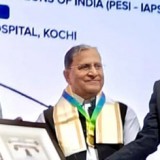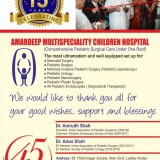INFORMATION AVAILABLE IN ENGLISH, GUJARATI AND HINDI
Cystic Hygroma: (Also read Lymphatic Malformations)
A cystic hygroma is a collection fluid-filled sacs known as cysts that result from a malformation in the lymphatic system.
A cystic hygroma is also known as a lymphatic malformation. The lymphatic system is a network of vessels within the body which form part of the immune system. Lymph nodes are located in the neck, armpits and groin areas and filter the lymph fluid.
What does a cystic hygroma look like?
Cystic hygromas can develop anywhere in the body, but are commonly found in the neck and armpits. It appears as a painless soft lump, which may be translucent.
What causes a cystic hygroma and can it be prevented?
A cystic hygroma forms when the lymph vessels fail to form correctly during the first few weeks of pregnancy. It cannot be prevented as it occurs so early in pregnancy, usually before the pregnancy is confirmed.
Nothing you did or did not do during pregnancy caused the cystic hygroma to develop. The exact cause of cystic hygromas is not clear. They occur in approximately one per cent of children and can affect children of any race and both boys and girls.
How is it diagnosed?
Cystic hygromas may be seen on scans during pregnancy. Many cystic hygromas are visible at birth or in early infancy, with almost all being diagnosed by the time a child is two years old. If the cystic hygroma is in a location where it may be interfering with other tissues and structures, scans such as ultrasound or magnetic resonance imaging (MRI) may be needed.
How can cystic hygroma be treated?
Sometimes cystic hygromas do not need to be treated. For babies, where the cystic hygroma is causing functional problems, the treatment options include surgical removal or injection sclerotherapy.
Surgical removal
Detailed scans will be needed to plan the operation, and it will only be carried out if the surgeon is confident that the operation will be beneficial. There will be an amount of scarring after the operation, as with all surgery.
Sclerotherapy
This is a procedure carried out under ultrasound guidance where a special medicine is injected into the cysts. The medicine mimics an infection, causing an inflammatory reaction, which makes the cystic hygroma shrink. It may take several sclerotherapy sessions for the cystic hygroma to be completely treated and even then, it might grow again.
Both surgical removal and sclerotherapy are carried out while the child is under a general anaesthetic. The doctors will discuss with you the treatment options suitable for your child. Some children may need both treatments.
Are there any risks with these treatment options?
Every procedure carries some risk of infection and bleeding. Your child will be given an antibiotic injection during their operation to reduce the risk of infection. Every anaesthetic carries a risk, but this is very small. Modern anaesthetics are very safe and your child’s anaesthetist is a very experienced doctor who is trained to deal with any complications.
With surgical removal and sclerotherapy, there is a small chance of damage to the structures surrounding the cystic hygroma. This is why detailed imaging scans are carried out before the operation. Even after the cystic hygroma has been removed or shrunk, there is a chance that it could return. Treatment can be repeated if needed.
What happens afterwards?
After the procedure, your child will return to the ward to wake up fully from the anaesthetic. The wound area will be covered with a dressing to protect it and a drain may be in place for the first few days then removed.
When you get home
• You should give your child pain relief medicines and a course of oral antibiotics.
• Your child will need to come back to the hospital for a check up appointment one to two weeks after the operation.
What is the outlook for children with a cystic hygroma?
The outlook is generally good, although the size and location of the cystic hygroma can influence long term outcomes. As explained above, cystic hygromas can come back after treatment, which would require another operation or sclerotherapy procedure.
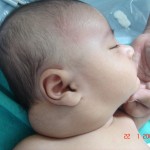
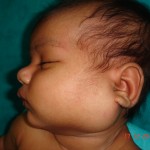 Cystic Hygromas in the neck
Cystic Hygromas in the neck
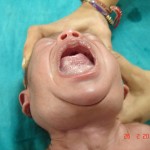 Bilateral Cystic Hygromas in the neck
Bilateral Cystic Hygromas in the neck
GUJARATI
લિમ્ફેન્જયોમા
બાળકનું શરીર બે કોષમાંથી આકાર લેતું હોય છે. આમાંથી ચેતાઓ, ધમનીઓ અને લિમ્ફેટીક નામની ગ્રંથિઓના કોષ પણ છૂટા પડતા હોય છે. લિમ્ફેટીક નામની નળીઓ બનાવતા કોષ જે નોર્મલ કોષથી છુટા પડીને ગાંઠ બનાવે તેને લિમ્ફેન્જયોમા કહેવામાં આવે છે. હિમેન્જયોમા એટલે કે લોહીની નળીઓની ગાંઠથી વિપરીત લિમ્ફેન્જયોમા તેની જાતે ક્યારેય મટતું નથી તેના માટે આપરેશન જરૂરી હોય છે. આપરેશન દરમિયાન જા ગાંઠ સંપૂર્ણપણે ન નીકળે તો ભવિષ્યમાં આ રીતની ગાંઠ ફરી થવાની શક્યતા રહે છે. હિમેન્જયોમાની જેમ જ લિમ્ફેન્જયોમા પણ શરીરના કોઈ પણ બાહ્ય અથવાતો આંતરિક અવયવ કે વિભાગમાં થઈ શકે છે. સામાન્ય પણે તો તે ગળામાં અથવા બગલમાં વધુ જાવા મળે છે. •
Hindi
लिम्फेंजीयोमा
बालक का शरीर दो कोशिकाओं में से आकार प्राप्त करता है। इसमें नसें, धमनियाँ और लिम्फेटिक नामक ग्ा्रंथियों की कोशिकाएं अलग हो जाती है। लिम्फेटिक नामक नलिकाएं बनाने वाली कोशिकाएं सामान्य कोशिकाओं से अलग होकर जो गांठ बनाती है उसे लिम्फेंजीयोमा कहा जाता है। हिमेंजीयोमा अर्थात खून की नलिकाओं की गांठ के विपरीत लिम्फेंजीयोमा कभी भी अपने आप ठीक नहीं होता है और उसके लिए ऑपरेशन जरूरी हो जाता है। ऑपरेशन के दौरान यदि गांठ पूरी तरह से नहीं निकाल ली जाती तो भविष्य में गांठ फिर से उभर आने की संभावना बनी रहती है। हिमेंजीयोमा की भान्ति लिम्फेंजीयोमा भी शरीर के किसी भी बाहरी अथवा अंदरुनी भाग में हो सकता है। •

